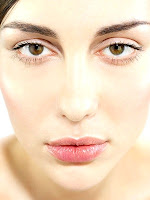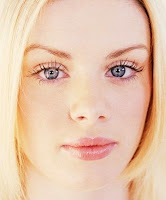The skin approach lower blepharoplasty is also know as transcutaneous lower blepharoplasty and anterior approach lower blepharoplasty. The main target of this surgery is to remove excess skin, orbicularis muscle, and fat from lower eyelids. Transcutaneous lower blepharoplasty may be performed with adjunctive procedures like lateral canthal reinforcement. This surgery can be performed under local anesthesia with oral sedation or intravenous sedation.
In skin approach lower blepharoplasty, the skin is incised along its complete length just below the eyelid margin. The skin is slightly incised beyond the lateral canthus. After that in a similar manner, exposed orbicularis muscle is incised along its full length. Skin muscle is then taken off from underlying orbital spectrum using cotton tip and sharp dissection with scissors. The dissection of skin muscle flap extends to the down side over the full lower eyelid to approximately orbital bony rim. Incision is made to the orbital spectrum to bring out fat pockets from lower eyelids. Excess fat is teased apart and clamped in transcutaneous lower blepharoplasty. Fat is lifted off with scissors. The surgeon asks patient to look upward towards forehead and drapes the skin muscle flap over initial incision to confirm the excess tissue. The blepharoplasty surgeon trimmed any excess tissue. After that surgeon closes the skin edges using sutures.

Thursday, December 27, 2007
Skin Approach Lower Blepharoplasty
at 12:34 PM
Tuesday, December 18, 2007
Benefits of Skin Resurfacing
Skin resurfacing is required to remove the fine lines on the face. Skin resurfacing doesn’t mean to tighten of skin, but it is required to forehead lifting, eyelid tightening and face lifting. Generally skin resurfacing is a medical procedure to improve the texture, clarity and appearance of skin. Skin resurfacing can also be done in conjunction with blepharoplasty.
Advantages: Blepharoplasty is performed to strengthen weakened structure and removal of extra tissue. Skin resurfacing procedures are performed to create a controlled injury in the dermis of the skin. This process leads to reduction of wrinkles in the lower eyelids during the healing from blepharoplasty. Nearly 50-80% of deep wrinkles is reduced by skin resurfacing and is reasonable to expect. The “cutting surgery” damages the skin due to skin creasing and may blunt the appearance of wrinkles in lower eyelids. Skin resurfacing improves the clarity and appearance of skin by reduction of wrinkles.
at 1:49 PM
Wednesday, December 12, 2007
Skin Resurfacing After Blepharoplasty

There are ablative procedures in blepharoplasty which include chemical peel and laser surfacing in variety of forms. The wrinkles are blunt by tightening within dermal layer of skin. New collagen is generating in skin surfacing and skin texture is altered. The outermost layer of eyelid skin is know as “Epidermis” and below epidermis is the “Dermis”. A mild oral sedation for anesthesia is required. Skin resurfacing is a destructive technique and performed just after blepharoplasty. Skin resurfacing is a non-surgical and stand alone procedure. After blepharoplasty, chemical is applied using Q-tips on the eyelids. Typically, tricholoacetic acid (TCA) is used for apply on the eyelids. 35% TCA solution is used for skin preparation and cleansing. Alpha- hydroxy acid is used for destructive resurfacing and deeper level of wounding. Chemical peeling must be repeated once a month for 5-6 months for better effect. Generally a single treatment is required for medium-depth peel. This can be accomplished by increasing the concentration of trichloroacetic acid (35-50%). Depth of chemical peeling with more potent chemicals is not predictable. Some surgeons use laser for resurfacing because energy is more controlled.
In laser skin resurfacing beam is directed over the tissue of skin. For stronger effect carbon dioxide laser (CO2) and for weaker erbium YAG laser is used. Sometime both the lasers are used in combination. The blepharoplasty surgeon checks the amount of energy required with the depth of penetration. Most of the surgeons prefer laser skin resurfacing because it is less destructive.
at 3:45 PM
Monday, December 10, 2007
New York City Blepharoplasty

Blepharoplasty in new york city is very famous. People are undergoing for blepharoplasty over the full face lift, because this surgery is easy, less discomfort and early recovery. You can experience the expected results and feel satisfaction after blepharoplasty. People under going blepharoplasty in new york city have good benefits. The surgical techniques used in new york city are the latest and totally modernize in the world. In most of the surgical centers laser treatment is used. This reduces your cost of blepharoplasty and recovers time and also you feel just little discomfort. If we talk about cost, then in new york city cost of blepharoplasty is quite low as compare to other places. For the full blepharoplasty (Upper and Lower), the cost will be around $2500-$3000 and it is very cheap as compare to full face lift or other cosmetic surgery. Sometime people called it as new york city blepharoplasty. You can easily find expert blepharoplasty surgeons in new york city. Here are some references that can help you a lot.
• Dr. Philip Miller, MD, FACS, New York plastic surgeon
60 East 56th, Third Floor, New York City, NY 10022
• NYU Medical Center, Department of Otolaryngology
530 First Avenue Suite 7U, New York City, New York 10016
• Scott J. Zevon MD, FACS
Central Park Plastic Surgery
75 Central Park West, New York City, NY 10023
• Z. Paul Lorenc, MD, FACS
983 Park Avenue, New York City, NY 10028
• Robert A. Guida, MD, FACS
8 East 75th Street, New York City, NY 10021
at 11:25 AM
Wednesday, December 5, 2007
Blepharoplasty for Repositioning of Eyelid Fat

Blepharoplasty can be performed for fat transfer, fat redraping, fat transportation, arcus marginalis release and septal reset. Fat injection and free fat grafting can also be performed under blepharoplasty. Some people have depression at the junction of lower eyelid and the cheek. This depression is caused by heredity or aging factor. The depression is appears as dark circle near lower eyelid.
Generally blepharoplasty is used to remove the depression or dark circle. In blepharoplasty, bulging orbital fat is used to camouflage the depression at the junction between lower eyelid and the cheek. Local anesthesia is acceptable for manipulation of wider area of tissue. Eyelid Fat Repositioning is not so much different procedure during blepharoplasty. It is just a different method to handle the bulging fat during blepharoplasty. Transconjunctival Lower Blepharoplasty is preferred to approach fat pockets. After that they are dissected out from thin capsules but not removed. Extra fat is then changed to uniform layer but remains connected to blood supply. This uniform layer of fat is reflected over the rim of bone into the area of depression. Sometimes this procedure is called as arcus marginalis release. This procedure comes under blepharoplasty. During the procedure, the fat is tucked under periosteum. Fat is usually elevated from the bone and anchored with removable sutures and tied on the cheek. After the completion of the blepharoplasty procedure, eyelids appear normal without extra fat.
at 12:25 PM